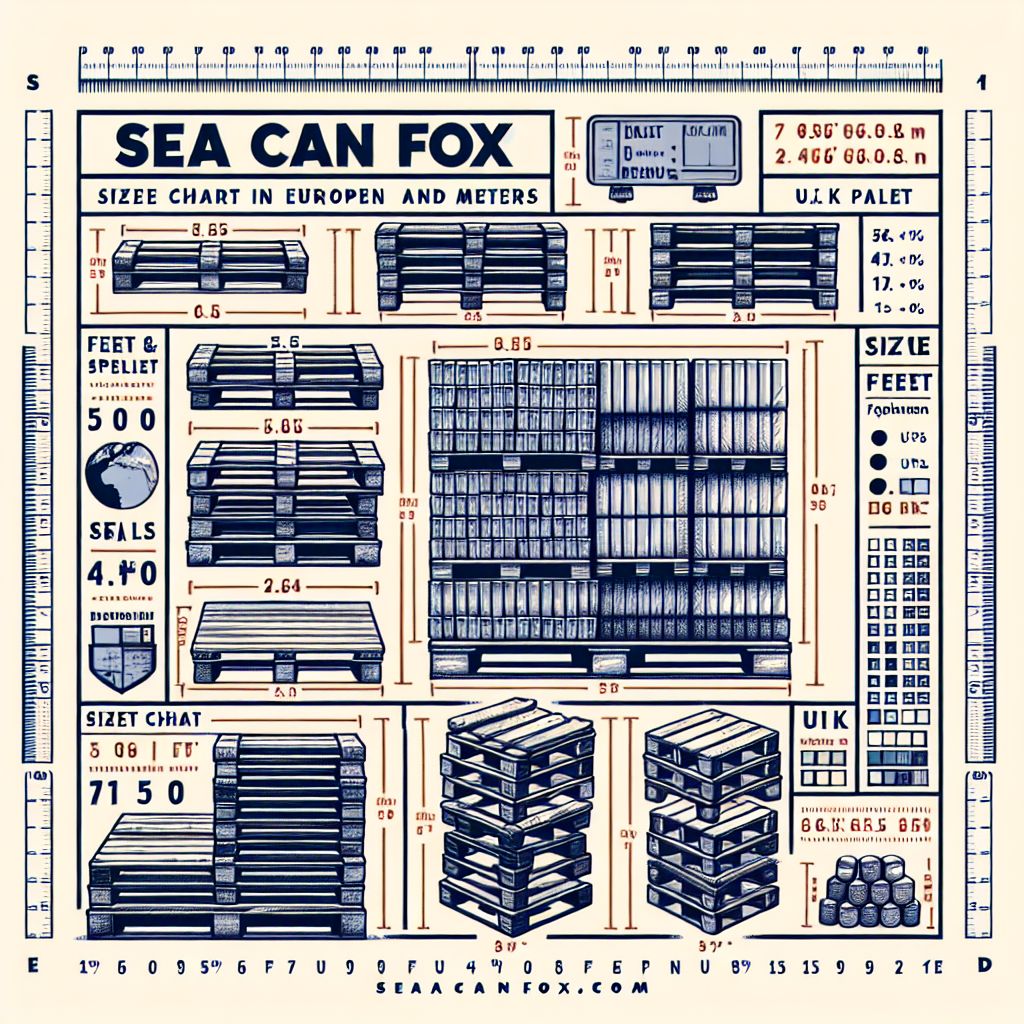
Key Takeaways
- Euro pallets measure 3.94ft x 2.62ft (1.2m x 0.8m) and support up to 1,500kg (3,307lbs).
- US pallets, commonly sized at 4ft x 3.28ft (1.22m x 1.02m), can bear loads up to 1,814kg (4,000lbs).
- UK pallets come in various heights, with the full pallet allowing a height of 7.22ft (2.2m) and a weight limit of 1,200kg (2,646lbs).
- Choosing the right pallet size can significantly reduce shipping costs and increase cargo safety.
- Understanding the dimensions and weight limits is crucial for optimizing shipping efficiency and complying with international standards.
Streamlining Your Shipping: The Power of Proper Pallet Sizing
When it comes to shipping, every inch and pound matter. The secret to cost-effective and efficient logistics lies in the details of your pallets. Let’s start by getting to know the Euro pallet, a widely-used standard in international logistics.
Euro Pallet Size Basics: Your Blueprint for International Shipping
Imagine you have a shipment ready to go to Europe. You’ve packed everything perfectly, but when the truck arrives, your cargo doesn’t fit. Why? You didn’t use a Euro pallet. This standard-sized pallet is designed to make the most of space in European trucks and shipping containers.
My Favorite Container Homes Resource
I compared the top 3 Container Home Guides
to discover the ultimate resource!
See my top recommendation here
Standard Dimensions in Feet & Meters
The Euro pallet, also known as a EUR-pallet or EPAL-pallet, is a block pallet that has been standardized in dimensions. It measures precisely 3.94 feet by 2.62 feet—or for those who prefer metrics, 1.2 meters by 0.8 meters. Its height, however, is a uniform 5.67 inches (0.144 meters). This size fits perfectly into many transport systems and minimizes wasted space, making it the go-to choice for European shipments.
Maximum Weight Capacity for Euro Pallets
Besides dimensions, weight capacity is a game-changer. A standard Euro pallet can carry up to 1,500 kilograms (3,307 pounds). This limit ensures safety during handling and transit, while also aligning with the capacity of equipment used in shipping and warehousing.
Optimizing the American Way: US Pallet Specifications
Now, let’s hop across the pond to the US. Here, the pallet size is slightly larger, and so is the weight it can carry. The US pallet is the workhorse of North American logistics, designed to fit perfectly in domestic transportation modes.
US Pallet Size for Ultimate Space Efficiency
The standard US pallet, often referred to as a “GMA pallet,” typically measures 4 feet by 3.28 feet (1.22 meters by 1.02 meters). This size is tailored to optimize the space in North American truck trailers and rail cars, ensuring that every square inch is used efficiently.
Calculating Weight Limits for Safe US Pallet Use
When it comes to weight, US pallets can support a hefty 1,814 kilograms (4,000 pounds). That’s about 500 kilograms more than their European counterparts. This extra capacity allows for the transportation of heavier goods without the need for additional pallets, reducing costs and handling time. For more detailed information on standard pallet sizes and dimensions, you can refer to industry-specific guidelines.
Maximizing UK Pallet Potentials: Navigating Size and Weight
Across the Atlantic, the
Understanding UK Pallet Dimensions
The standard full UK pallet measures 3.94 feet by 3.28 feet (1.2 meters by 1 meter) in its base dimensions. However, the real difference comes in height options. UK pallets offer more versatility with full, half, and quarter pallet height options, allowing for taller and more customized stacking configurations.
Guidelines on Weight Distribution for UK Pallets
When it comes to weight, UK pallets are robust. A full UK pallet can handle up to 1,200 kilograms (2,646 pounds). Half and quarter pallets are designed for lighter loads, but they offer greater flexibility for smaller shipments. It’s all about finding the right balance between the weight of your cargo and the pallet size that fits it best.
Differences and Similarities among Euro, US, and UK Pallets
Understanding the differences and similarities among Euro, US, and UK pallets is crucial. Euro pallets are compact and standardized, ideal for shipments in Europe. US pallets are slightly larger and can carry more weight, aligning with North American transport systems. UK pallets offer various height options, providing flexibility for stacking and storing goods.
Decision Matrix: Selecting the Optimal Pallet for Your Shipment
Selecting the right pallet involves more than just measuring your cargo. You need to consider the destination, the transport method, and the nature of the goods you’re shipping. Use a decision matrix that includes factors such as compatibility with handling equipment, potential for stacking, and adherence to international shipping standards.
- Consider the destination’s standard pallet size.
- Assess the compatibility with your handling and storage equipment.
- Factor in the nature and weight of your goods.
- Think about the potential for stacking and storage efficiency.
- Check for any specific industry or international standards that apply.
With these considerations in mind, you can make an informed decision that optimizes your shipping process, saves you money, and ensures the safety of your goods.

Pallet Size and Weight Table
| Type | Size in Feet (L x W x H) | Size in Meters (L x W x H) | Weight Limit |
|---|---|---|---|
| Euro Pallet | 3.94 x 2.62 x 0.47 | 1.2 x 0.8 x 0.144 | 1,500 kg (3,307 lbs) |
| US Pallet | 4 x 3.28 x 0.47 | 1.22 x 1.02 x 0.144 | 1,814 kg (4,000 lbs) |
| UK Full Pallet | 3.94 x 3.28 x 7.22 | 1.2 x 1 x 2.2 | 1,200 kg (2,646 lbs) |
| UK Half Pallet | 3.94 x 3.28 x 3.94 | 1.2 x 1 x 1.2 | 500 kg (1,102 lbs) |
| UK Quarter Pallet | 3.94 x 3.28 x 2.62 | 1.2 x 1 x 0.8 | 250 kg (551 lbs) |
References:
https://internationalforwarding.co.uk/2022/09/standard-pallet-size-uk/
https://www.nationalpallets.co.uk/content/pallet-sizes
https://palletonline.co.uk/pallet-size
https://www.universalpallets.com/2018/03/ultimate-guide-pallet-sizes-2/
https://www.agi.global/news/uk-standard-pallet-sizes-complete-guide-to-what-size-you-need
Maximizing Shipping Efficiency with Smart Pallet Choice
Choosing the right pallet is a strategic decision that can lead to significant cost savings and operational efficiency. It’s not just about fitting your goods onto a slab of wood or plastic; it’s about understanding how that choice affects every step of your supply chain.
Practical Tips for Choosing the Right Pallet
Here are some hands-on tips to ensure you’re selecting the best pallet for your shipping needs:
- Match the pallet size with the standard sizes used in your destination country.
- Consider the type of goods you’re shipping and select a pallet with the appropriate weight capacity.
- Think about the handling and storage equipment you’ll be using and ensure compatibility.
- Look for opportunities to reduce shipping costs by optimizing space with the right pallet size.
- Always follow safety guidelines to prevent accidents during transport and handling.
By following these tips, you can streamline your shipping process, reduce costs, and ensure your goods arrive safely at their destination. Remember, a smart pallet choice is a cornerstone of efficient logistics.
Impact of Pallet Selection on Shipping Costs and Efficiency
Choosing the correct pallet for your shipment is not just about the fit—it’s a strategic decision that affects your bottom line. The right pallet minimizes wasted space, reducing the number of shipments and thus lowering overall shipping costs. It also ensures that your goods are protected, reducing the risk of damage during transit and the associated expenses. Moreover, selecting a pallet that is commonly used at your shipment’s destination can avoid delays and additional costs that can occur when incompatible pallets are used.
Advanced Pallet Knowledge
Now that we’ve covered the basics, let’s delve into the finer points of pallet use. Knowledge is power, and understanding the nuances of pallet specifications can make a big difference in logistics efficiency.
First, consider the materials. Pallets are typically made from wood, plastic, or metal, each with its own advantages and disadvantages. Wood is the most common due to its cost-effectiveness and strength, but plastic and metal pallets offer durability and reusability that can be more cost-effective over time.
The Evolution of Pallet Dimensions
Pallet dimensions have evolved over time to meet the needs of global trade. Initially, pallet sizes were based on the transport modes and storage facilities available. As international trade grew, so did the need for standardization, leading to the development of the Euro pallet and the standard US pallet sizes we know today.
Pallet Material Types: Wood vs. Plastic vs. Metal
When choosing a pallet, consider the material:
- Wood: Affordable and sturdy, but susceptible to moisture and pests.
- Plastic: Resistant to moisture and pests, easily sanitized, but more expensive.
- Metal: Extremely durable and ideal for heavy loads, but much heavier and more costly.
Your choice will depend on factors like budget, shipment weight, and whether you’re shipping domestically or internationally. For more details on sizes and dimensions, you might consider looking into container size options.

Frequently Asked Questions (FAQ)
Can I use a Euro pallet for shipping to the US?
Yes, you can use a Euro pallet for shipping to the US. However, it’s important to note that the Euro pallet is smaller than the standard US pallet, which might affect how your goods fit into American transportation systems. It’s often more efficient to use the pallet size that is standard in the destination country.
What are the consequences of exceeding a pallet’s weight limit?
Exceeding a pallet’s weight limit can lead to pallet failure during handling or transit, which can damage your goods and create safety hazards. It can also lead to increased costs due to damaged goods, repackaging, and potential fines or penalties for non-compliance with shipping regulations.
Are pallet dimensions standardized globally?
Pallet dimensions are not standardized globally. While there are common sizes like the Euro and US pallets, different countries and regions may have their own standards. It’s crucial to research and use the appropriate pallet size for your shipment’s destination.
How do pallet sizes impact shipping costs?
Pallet sizes directly impact shipping costs by affecting how efficiently space is used in transportation vehicles and containers. The better the fit, the more goods you can ship at once, potentially reducing the number of trips required. Additionally, using standard pallet sizes can prevent additional handling and repackaging costs.
Why are UK pallet dimensions different from Euro and US sizes?
UK pallet dimensions are different primarily because of the historical development of supply chains within the region. The UK has developed its own standard sizes to fit its particular transportation and storage systems, which differ from those commonly used in Europe and the US.
Understanding the different pallet sizes can be crucial for businesses when planning their shipping strategy. The standard dimensions of pallets vary globally, with the Euro pallet, the US pallet, and the UK pallet having distinct sizes and weight capacities. For example, the Euro pallet typically measures 1200mm x 800mm, while the US pallet is often 48 inches x 40 inches. In the UK, the standard pallet size is 1200mm x 1000mm. Knowing the exact dimensions and weight limits for each can help in optimizing container space and potentially reducing shipping costs.






Leave a Reply